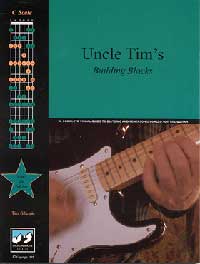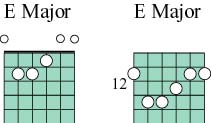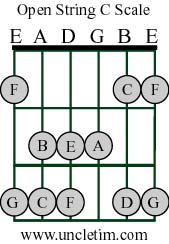

By Tim Gillespie
Scales!
Learn how to solo once and for all!
Soloing is like learning to talk. Knowing the words in not enough. You have to be able to form phrases in the key and then transform them into statements. There is no time to read music notation or learn where the notes are when forming a solo. You have to show up with this information already in place. Building Blocks will show you this using images because once you have the image in your head, you know exactly where to go and you can do it on the spot.
There is nothing like it and nothing can make up for it. For $20, you can put this all to rest right now. Pick up a copy today.
eBooks are delivered instantly!
My favorite! I love scales. Really! If I play scales regularly, I feel better! My playing sounds crisper to me, and my tactile response is almost always better. This may sound strange, but if I play scales early in the day, it seems to make me happy throughout the rest of the day.
I have played scales for about 25 years. Not every day, but most days. Not for an hour a day but often for that much, sometimes for much longer periods. If I was going to improvise that night, I would spend about an hour before the jam session revisiting my scales and warming up my hands. After a short break (about 15 to 30 minutes) I was ready to plug in this technical practice with the creative part. Besides being lots of fun, this got me noticed. And that was fun too.
Improvising relies heavily on scales. I usually find myself thinking about traveling to different parts of the fretboard using a scale as the path. If I get locked in to a song, I don't spend many brain cycles worrying about the exact notes. After a few years they take care of themselves. My job is to use the available notes to create interesting and expressive combinations and passages and blending this with the music the other musicians were playing. Of all the different way of playing a guitar I have encountered, this is undoubtedly my favorite.
Once a very pretty young lady introduced herself to my father and started going on about what a great guitarist I was. My father then proceeded to sit down with me, and for the first time he really paid attention to what I was doing (with an eyebrow raised). This ability to change scales into tasteful musical improvisations had far ranging implications. Much farther than I thought at the time. But one thing is certain, scales were the first major step in shaping my abilities. When I first learned how to really use them, it was like receiving an electrical shock. If you have read the page for Uncle Tim's Building Blocks you can see why they are so important to me.
I think I look at scales differently than most people. I usually don't think about small fragments as the scale. I usually think of scales in twelve fret increments. People in general seem to have trouble with this. When I tell them the scale of C extends over the entire fretboard and not just the few frets they have memorized, I usually get blank stares. There are several reasons why, and that is what we will discuss this month.
If you can understand these reasons, you too will start to think of scales in twelve fret increments. And you may find that this tool will greatly simplify understanding the guitar. Remember this, everything concerning the guitar can be traced back to scales. Anything you play on a guitar is either a scale or a chord. Chords are derived from scales and scales define keys. Even when mastering diatonic keys has become easy, scales provide an avenue into the unknown. As you will see, looking at the signature of a scale will make it easy. Very easy.
First of all, why twelve frets? The guitar repeats every twelve frets. Everything on a guitar repeats every twelve frets. The beginner chords we all learned at the first to third frets all repeat at the twelfth to fifteenth frets. The only difference is the open strings must now be barred at the twelfth fret. You can actually play these chords holding down the notes of the chord around the twelfth fret and playing the open strings as you do with the open string chords. But the open strings will now be an octave lower than the notes you are holding down.
 Here
are two examples of E major. The first example is E major as an open string
chord. The second one is of E major played as a barre chord at the twelfth
fret. Everything that was played as an open string is now played by barring
the strings at the twelfth fret. THE OPEN STRING CHORDS REPEAT AT THE
TWELFTH FRET.
Here
are two examples of E major. The first example is E major as an open string
chord. The second one is of E major played as a barre chord at the twelfth
fret. Everything that was played as an open string is now played by barring
the strings at the twelfth fret. THE OPEN STRING CHORDS REPEAT AT THE
TWELFTH FRET.
Everything repeats twelve frets higher. So let's look at an example of a scale repeating twelve frets higher. Try this yourself! Play the first chord with your second, third and fourth fingers. Move the whole thing up to the position of the second chord. Now just place your index finger on the twelfth fret. Voila! Barre chords are derived from open string chords. Try it with others.
 Here
we have the open string C scale. Before we go any furthur, let's look
at a couple of typical questions I hear:
Here
we have the open string C scale. Before we go any furthur, let's look
at a couple of typical questions I hear:
1. Doesn't the C scale start at the C note? Actually the C scale starts with the very lowest note available that is in the key. The very lowest note available on the guitar (tuned standard) is the open string E note. The key of C contains the E note so that is the lowest note available in the key of C. So I always start with the lowest note available and play them all. Notice this diagram only contains the notes C, D, E, F, G, A and B. These are the notes in the key of C and these are the only notes we are working with.
2. Should I practice starting at the C note or the E note? Practice it all. The full range of notes. Give your fingers the benefit of a full range of motion. Sure you can play different exercises that stop at the C note, but make sure you are playing the full range of motion. You will naturally want to stop at the C note anyway. It brings this scale to rest. Play with this.
Now let's look at a twelve fret scale signature of C major
as it repeats.  Notice the same open string scale above is shown in yellow. Also notice
the same notes repeat at the twelfth fret. The only difference is the
notes that were played open in the first example are now played by using
the notes at the twelfth fret. This will always work. This is the basis
of the principles of barring notes and chords.
Notice the same open string scale above is shown in yellow. Also notice
the same notes repeat at the twelfth fret. The only difference is the
notes that were played open in the first example are now played by using
the notes at the twelfth fret. This will always work. This is the basis
of the principles of barring notes and chords.
This means if you want to know the entire scale for the key of C, just focus on the first twelve frets. Does this make it harder or easier? Here is my answer; much easier! Once you get accustomed to looking at scales this way, you will begin to get famliar with the entire personality of the scale.
Not only are the beginner scale fragments present but also all the advanced fragments. You can also experiment with playing the scale all over the fretboard. Many people know a C scale between the first and third frets but not anything higher than that. Keep in mind that you are not just seeing the scale of C but also the key of C major. All the notes that are in the key of C are in this diagram. All of them. Also all the notes in the key of A minor natural are here. If you want to derive the chords in the key of C major or A minor, all you have to do is learn the rules and connect the dots! I am saying ALL THE THEORY FOR THE KEY IS DIRECTLY VISIBLE! Spend a little time getting to know what to look for and the whole thing becomes understandable. This will give you great freedom to play leads and improvise. This freedom is a lot of fun. Lots and lots of fun! But this also gives you a chance to size up the key before you even start to play.
Ok , so let's take a look.
Here is something that will help you get a grip on this. A scale in C major uses the notes C, D, E, F, G, A and B. You can start with any of these notes and climb or descend alphabetically. That is how you play a scale. But the path you choose can be one of several. You can take the path of the open string (yellow) notes, or climb higher up the neck. There are reasons to consider both pathways. Some scales will require giant stretches and others will only require small compact fingerings.
 This
is the same graphic as shown to the right, only for twelve frets. Now
we are going to see another pattern that lives right on top of the open
string scale. This is a very useful scale and pathway. It covers over
two octaves, starts low and climbs high, and gives you the chance to move
all over the fretboard.
This
is the same graphic as shown to the right, only for twelve frets. Now
we are going to see another pattern that lives right on top of the open
string scale. This is a very useful scale and pathway. It covers over
two octaves, starts low and climbs high, and gives you the chance to move
all over the fretboard.
This scale will build up hand strength like crazy. After a while you may even try barring the G, C and F notes at the low end of the pattern. This will be easier on an electric guitar.
The gray notes on top of the yellow notes forms another pattern (down the page). You need to borrow the C note on the high E string to remain alphabetical. But with these three scales we have covered the entire signature. If you want to know every scale in the key of C, here it is.
So by looking at the twelve fret signature, you can see all the scales for the key of C. ALL OF THEM. Sure there are a few pathways you can travel in here that we have not exposed yet. You can use pieces of the scales we are talking about and form new paths. After you play these patterns for a while, you will start to notice others. This can be very exciting. Remember these are not just scales but the building blocks of all lead guitar. There is more here than we have talked about. In fact this can be the beginning of understanding almost all theory for the guitar.
Ok so now look at this signature again. Can you focus on the different pathways we have talked about? Can you see there are no notes on the eleventh fret? This marker will become very important as you apply this to other keys. Why? Here is why! Every other key will use this exact same signature for all of their scales too (this is for later). Learn it for the key of C and then knowing all the scales in every key is within a few days work. This is enormous information. It is the whole ball of theory wrapped into a nice neat signature that will get easier to use every day. You can go from questioning to knowing in a few weeks.
Consider this. If you have a favorite scale fragment in any of the 24 diatonic keys. I can show it to you right in this signature. It will be positioned for the key of C, but it will be here. Any diatonic fragment!
This is another scale run in the key of C. This one is conveniently located right on top of the first animation. Use your first, second and fourth fingers for all the notes except the notes on the high E string. For those notes use your first, third and fourth fingers.
Parting comments. Often times people will bring me a diagram like this above. The questions usually revolve around a small tiny scale fragment. These people seem to be struggling with understanding where the scale of C could be hiding in the picture. In fact the picture is the scale of C and all the little tricks that are hidden away in it! This is how I look at scales!
All of this is covered in detail in Uncle Tim's Building Blocks, including mapping every key to serve as a long term resource. See the best scale book for visually understanding the guitar, Uncle Tim's Building Blocks.